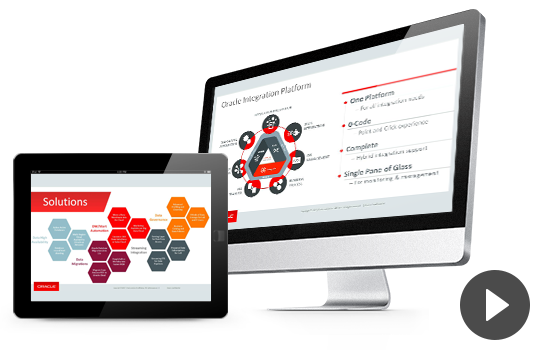Oracle Unifies Data-Centric Tools To Bring Simplicity, Speed, Automation to Business Outcomes
Data transformation often relies on smarter and coordinated access to accurate data. Oracle is unifying under a single, cloud-based umbrella 5 technologies for top-of-mind data tasks. IDN speaks with Oracle’s Jeff Pollack about Oracle Data Integration Platform Cloud service.
by Vance McCarthy
Tags: cloud, data, ETL, governance, integration, management, migration, Oracle, platform, replication, synchronization,

VP of Product Management
Oracle Data Integration

"It’s not just about [Oracle DICP] technical capabilities. We’re really looking to focus on the ‘business outcomes’ our customers are trying to achieve with their data."
In 2018 successful digital transformation often relies on having a nimbler, integrated and coordinated approach to using data.
In that vein, Oracle is looking to help companies solve a number of important – yet pesky and complicated -- data-centric issues with a novel approach. The Oracle Data Integration Platform Cloud Service unifies under one umbrella several of Oracle’s most popular data integration technologies in the cloud, Jeff Pollock, VP of Product Management, Oracle Data Integration told IDN.
Among the under-the-umbrella technologies are: Oracle GoldenGate, Oracle Data Integrator and a host of Oracle’s data management and governance solutions.
The goal of Oracle’s DICP, Pollack said is basically to craft a new form-factor, where users can more easily tap one of more of these data-centric technologies – and more quickly results across five (5) basic ‘business solution’ areas.
- Data continuity
- Data migration
- Data warehousing
- Streaming integration and
- Data governance
Oracle DIPC Brings Simplicity, Automation with ‘Elevated Tasks’
DIPC unifies Oracle’s most popular data integration technologies together on a cloud platform. But the business value from DIPC’s approach looks to deliver more than the sum of its 5 technologies, Pollack said.
“It’s not just about the technical capabilities,” Pollack said, “We’re really looking to focus on the ‘business outcomes’ our customers are trying to achieve. With an outcomes focus, we think we can simplify and automate more [of those] processes.”
With these capabilities, Oracle DIPC aims to simplify and accelerate “many complex and time-consuming” data-centric jobs, Pollack said. Among them are many common headaches for data and IT professionals:
- Perform bulk or real-time data movement for cloud onboarding.
- Complex data synchronization across two or more databases (with minimal or no downtime thanks to active-active support).
- On-going support for data warehouses, as well as getting that data to align with new data sources
- ETL (extract, load, and transform) data entities.
- Replicate and synchronize selected data sources.
- Integrate with big data technologies to ingest, transform and stream data.
- Maintain and govern data quality with prebuilt processes.
- Data profiling and validation.
To do all this, Oracle DIPC marries its discrete data integration engines with a set of best practices and rules to simplify – and even automate – much of the tedious work that often requires multiple IT staff, he added. The result is what Pollack called “elevated tasks,” high-level tasks, such as replicate database A to database B – without having to take either one of them down
Pollack likened the approach to what happens in the kitchen of a great restaurant.
“The idea is that you can take five or six different core ingredients, and then assemble them in different ways to produce different meals the customer ordered,” Pollack said. “The DICP service, at a functional level, has got five or six engines, and depending on the way those engines are used together, you're basically producing different outcomes. And outcomes are our focus here, like a meal.”
To make the approach even tastier to users, Oracle DIPC also sports a unified UI. This dual-level of integration (both for the UI and at the platform level) delivers ease-of-use and intelligent automation. The result, Pollack said, is a new way of thinking about many top-of-mind data integration tasks, something he called ‘elevated tasks’.
Inside Oracle DIPC’s ‘Elevated Tasks’ – A Practical Use Case

Pollack explained ‘elevated tasks’ this way:
“To make it easier for our customers to consume [all these data services], we give them a fully integrated user experience. Users can have a common IDE or a common development experience across multiple [engines], and that removes many of the technical silos” he said. The result: customers don’t need multiple developers who specialize in using different tools.
To get a flavor for how DICP works in real-life, Pollack shared a practical use case around data synchronization, comparing how it’s is traditionally done versus using ‘elevated tasks’:
In the old world, with a tools-based approach, you would have had to have potentially two different developers working with two or three different toolkits to perform a simple database synchronization job.
You might use Oracle data pump to drop a bunch of data. You move it or import it onto the other side to the second database. That would be your sort of bulk initiation. Then you might need somebody to set up the replication flows, so you'd have to have a DBA set up something like a timestamp-based checkpoint for when to begin capturing transactions.
And then, once the bulk load was done, you'd have to then go deploy the replication tool to synchronize the database to catch-up the new one with the old one. After all that, once [the databases are caught up] you would have the replication service still running to be sure you kept them in sync.
So, in the end, for simple replication you get this sort of multi-step process where you're doing some batch workloads, some real-time replication work. And, to do this you've got some DBAs involved, you might have ETL developers involved and perhaps others.
“With ‘elevated tasks’ we were looking to radically simplify a wide range of data-centric tasks, as well as cut the amount of IT staff needed,” he added. “As a case in point, a data replication task using DIPC service can be done in as little as a ‘three-click’ operation,” Pollack said.
“In the UI, users just declare they want to achieve a database replication task, where users can really drag and drop sources and targets. That’s where you now can basically just choose with a picklist which tables you want to replicate. You then go ahead and click the ‘go’ button,” he said.
“Underneath the covers [from the UI], we do things like install and deploy GoldenGate and install Data Integrator and we’ll actually create a bulk data job (using an ETL job to do the initial bulk load). We’ll also automatically set the checkpoint and begin capturing transactions on database A so that when it's time to cut over that you can catch up database B and you know that the two are in sync with each other.”
The key takeaway is simply this, Pollack said:
“Once we know the ‘elevated task’ the user wants to accomplish, DIPC can automate a lot of the complexities that used to have to be done manually. We simply ‘drag’ that task in by incorporating some assumed steps – which are done automatically in software under the covers.”
The ‘elevated task’ approach also sets an exciting future for DIPC, Pollack added. “In the long run, this approach also brings with it the opportunity to start to inject more artificial intelligence, more machine learning and more cognitive services.”
For all the value the fully-integrated Oracle DIPC service can offer users, Pollack emphasized customers don’t have to use it all. There are mix-and-match options, he said. As an example, a customer using Informatica PowerCenter for ETL can continue to use that, and simply choose to use the Oracle GoldenGate component for data replication, he noted. “We’re committed with [Oracle DIPC] to be 100% heterogeneous,” Pollack said.
Oracle DIPC is available in three editions – standard, enterprise and governance.
Related:
- Tray Enterprise-Class AI Platform Casts Light on “Shadow MCP” and Controls “AI Sprawl”
- Xano 2.0 Updates Production Grade Backend for AI, Apps To Solve "Vibe Coding Trap"
- Ai4 2025 Vegas Wrap-Up: What Enterprises Need to Know About Emerging AI Solutions
- Boomi Agentstudio Looks To Deliver Full-Featured Management Platform for AI Agents
- Agentic AI: Unlocking Business Value with the Next Evolution in Enterprise Intelligence
All rights reserved © 2025 Enterprise Integration News, Inc.



